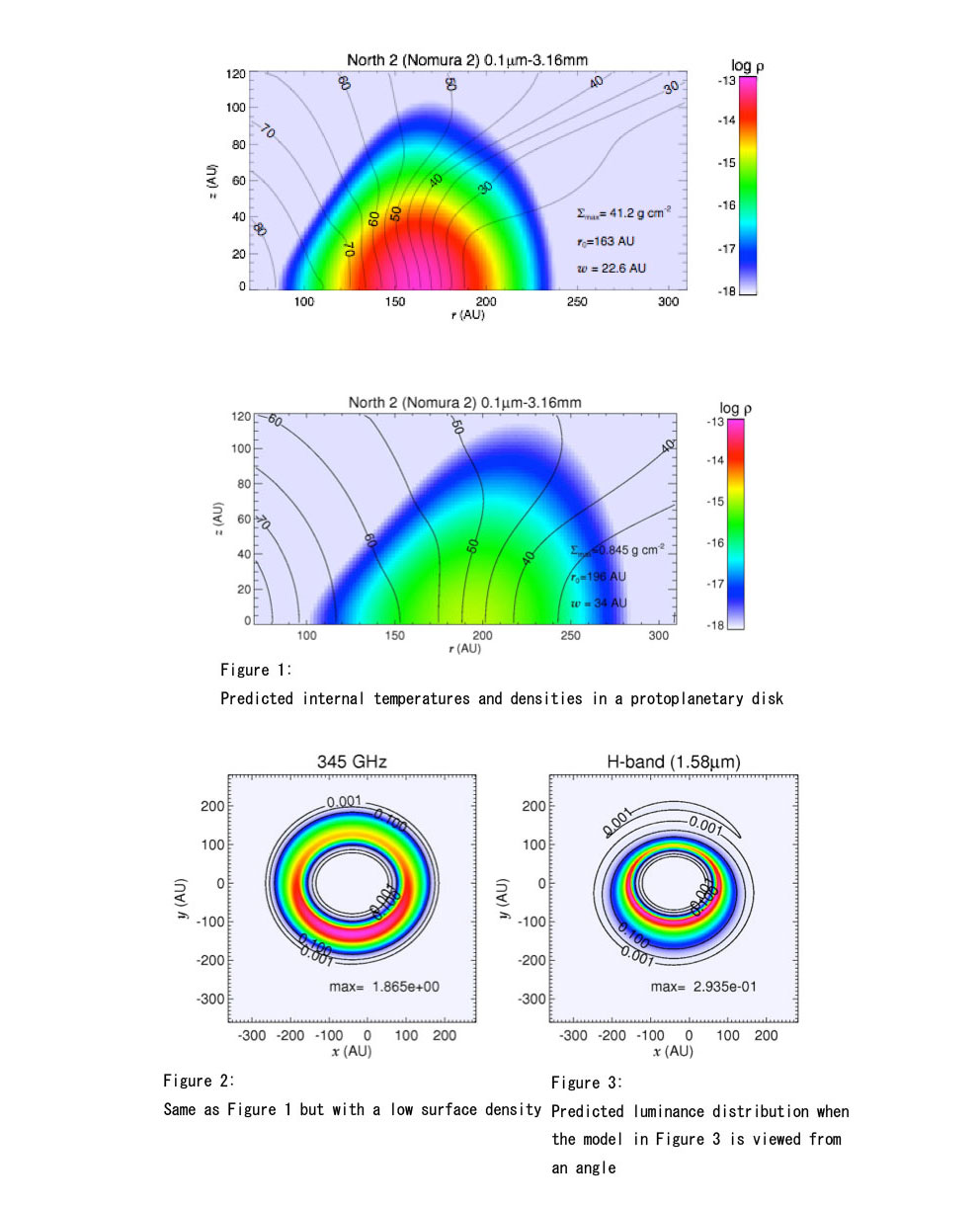Home > For Researchers > Public Research > Introduction of adoption public research ⑥
Introduction of adoption public research ⑥
Construction of a multi-wavelength radiation equilibrium model for protoplanetary disks
(Tomoyuki Hanawa/ University of Chiba)
As a result of observations in recent years, protoplanetary disks – the places where planets form – have been found around many pre-main-sequence stars, and it has been discovered that these disks have a variety of different physical structures at different stars. In order to identify the factors which cause this diversity in protoplanetary disks, it is important to identify various physical quantities for individual astronomical objects. In particular, identifying the age of an astronomical object is essential for determining the evolutionary process of the pre-main-sequence star. The age of a pre-main-sequence star is generally determined by measuring the brightness and effective temperature by photometric observations and comparing them with the stellar evolutionary model. However the brightness of a pre-main-sequence star found from photometric observations contains uncertainties of distance, extinction, and veiling. Therefore the age calculated from the brightness also contains large uncertainty. In addition, there remains considerable uncertainty in the debate over the evolutionary process.
In order to accurately find the age of a pre-main-sequence star, a new method of determining the age with less uncertainty is needed. As a pre-main-sequence star evolves, it contracts and becomes denser. As a result, if it is possible to find the star’s surface gravity, then it will be possible to derive the star’s age. The gravity of a star can be found from the equivalent width of the star’s atmospheric spectrum obtained by high-dispersion spectrometry. Because the equivalent width is a quantity equivalent to the strength of the absorption line normalized by the continuous light intensity, it is not dependent on the distance of the star or the amount of extinction. In addition, by calculating the equivalent width ratios for nearby absorption lines, a quantity is obtained which is also not dependent on veiling. This means that it is possible to eliminate the above problems which interfered with photometric observation. So far, we have used the Fe and Na absorption lines in the visible light region, and the Sc and Na absorption lines in the near-infrared region to establish a method for accurately determining the age of a pre-main-sequence star.
Based on this new method of age determination, we determined the age of pre-main-sequence stars in the Taurus Molecular Cloud and identified their evolutionary timescales. Because a protoplanetary disk generally contains large amounts of gas and dust, it is expected to become thinner over time, however no correlation was found between the age of the pre-main-sequence star determined from its brightness and the degree of disk evolution. While it is possible that the protoplanetary disk evolutionary timescale is different for each disk, there is also the possibility that the timescale has not been correctly understood due to the uncertainty in the pre-main-sequence star brightness. When we investigated the relationship between the age of the pre-main-sequence star found with the new age determination method and the degree of disk evolution, we found a correlation that had not been identified before (Figure 1). From these results, we discovered that the timescale for dissipation of the protoplanetary disk of a pre-main-sequence star in the Taurus Molecular Cloud is approximately 3 – 4 million years. This is an extremely important result in terms of the discussion about universal evolution of protoplanetary disks.
Using the same method as in Taurus, we also investigated the disk evolution timescale of pre-main-sequence stars in the Ophiuchus Molecular Cloud. The results showed that the evolutionary timescale of a protoplanetary disk in the Ophiuchus Molecular Cloud was approximately 1.6 million years, or about half that in the Taurus Molecular Cloud. This shows that the evolutionary timescale for protoplanetary disks varies depending on the star-forming region. Possible causes of the differences in evolutionary timescales in different molecular clouds may include the initial mass of the molecular cloud and the distribution of nearby massive stars. One possible cause that has been little studied is the effect of the metal content. For example, based on the results from exoplanet observations, it was found that the higher the metal content of a star, the more likely it is to have planets. Model computations also show that the timescale for dissipation of the protoplanetary disk by radiation from the center star is dependent on the metal content. Therefore it is possible that the evolutionary timescale and evolutionary path of a protoplanetary disk depends on the metal content. Although the metal content can be determined by high-dispersion spectrometry, the absorption lines are observed weaker than they would otherwise be due to the effects of veiling. As a result, it is difficult to find the amount of veiling and surface gravity independently. However by using the equivalent width ratio that is used in this study, the star’s surface gravity, temperature, and metal content can be quantified without being affected by veiling. This study accurately determined the metal content of a pre-main-sequence star and identified the dependency of protoplanetary disk evolution on the metal content, contributing to development of a more universal picture of planetary evolution.

Correlation between age of a pre-main-sequence star in the Taurus Molecular Could (horizontal axis) and degree of disk evolution (vertical axis – the amount of infrared transmission from the disk seen in the near-infrared range). This shows how the protoplanetary disk gradually dissipates over 3 – 4 million years.
